247 scholarly books by University Press of New England and 15
have author last names that start with K
247 scholarly books by University Press of New England and 15
247 scholarly books by University Press of New England
15 have author last names that start with K have author last names that start with K
15 have author last names that start with K have author last names that start with K

I Heart Obama
Erin Aubry Kaplan
University Press of New England, 2016
In his nearly two terms as president, Barack Obama has solidified his status as something black people haven’t had for fifty years: a folk hero. The 1960s delivered Malcolm X and Martin Luther King, forever twinned as larger-than-life outsiders and truth tellers who took on racism and died in the process. Obama is different: Not an outsider but president, head of the most powerful state in the world; a centrist Democrat, not the face of a movement. Yet he is every bit a folk hero, doing battle with the beast of a system created to keep people like him on the margins. He is unique among presidents and entirely unique among black people, who never expected to have a president so soon. In I Heart Obama, journalist Erin Aubry Kaplan offers an unapologetic appreciation of our highest-ranking “First” and what he means to black Americans. In the process, she explores the critiques of those in the black community who charge that he has not done enough, been present enough, been black enough to motivate real change in America. Racial antipathy cloaked as political antipathy has been the major conflict in Obama’s presidency. His impossible task as an individual and as a president is nothing less than this: to reform the entire racist culture of the country he leads. Black people know he can’t do it, but will support his effort anyway, as they have supported the efforts of many others. Obama’s is a noble and singular story we will tell for generations. I Heart Obama looks at the story so far.
[more]
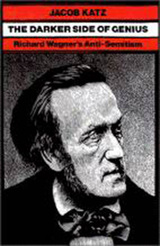
The Darker Side of Genius
Richard Wagner’s Anti-Semitism
Jacob. Katz
University Press of New England, 2002
For some, Richard Wagner is infamous as the favorite composer of Hitler, who seems to have admired Wagner as an early exponent of his own racist ideology and worldview. Impressed by this assumption victims of Hitler have also associated Wagner and his music with Nazism to such an extent that in Israel a ban on public performance of that music is upheld to this day. Jacob Katz, a scholar of international repute, approaches the highly charged issue of Richard Wagner’s anti-Semitism with the tools of a critical historian, asking two central questions: What role did anti-Semitism play in the life and work of Richard Wagner? And how did his anti-Jewish thoughts and sentiments contribute to the development of political anti-Semitism and Nazism? In this first comprehensive and judicious treatment of Wagner’s anti-Semitism, Katz analyzes the composer’s attitudes in their own time and place and in the context of Wagner’s life and aspirations. He traces Wagner’s feelings toward Jews chronologically, showing that the composer was ultimately obsessed by a deep-seated Judeophobia generated by conflict with his Jewish mentors and competitors. But he argues against reading the later emergence of Nazism back into Wagner’s life and work. While not absolving Wagner from responsibility for his views, Katz contends that contemporary Jews have paradoxically and uncritically adopted the Nazis’ assumptions about Wagner. Katz argues that Wagner’s music is untainted by his anti-Semitism, that there is, in fact, very little in Wagner’s art that, without forced speculation, can be related to his racist views.
[more]
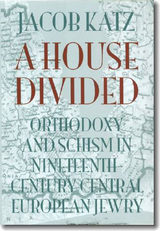
A House Divided
Orthodoxy and Schism in Nineteenth-Century Central European Jewry
Jacob Katz
University Press of New England, 2005
Eminent social historian Jacob Katz examines the rise and transformation of Jewish communal leadership in Central Europe. It is a story of fragmentation and polarization that sheds light on the tensions within the 19th-century Jewish community in Central Europe as it struggled to respond to the promises and perils of modernization.
[more]
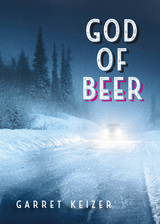
God of Beer
Garret Keizer
University Press of New England, 2016
In the remote mill town of Salmon Falls, Vermont, the dead of winter can feel like death itself. Jobs are scarce, kids are bored, and it sometimes seems there’s nothing better to do than drink. But when eighteen-year-old Kyle Nelson and a motley group of friends decide to challenge both the legal drinking age and the local drinking culture with a daring act of civil disobedience, they find there’s more to do than they ever imagined. Garret Keizer’s gripping novel about young men and women in revolt bears witness to the power of ideas, the bonds of friendship, and the trials of working-class kids on the margins of American society. His story never flinches in the face of those forces that conspire against, but needn’t overcome, the resilient spirits of the young.
[more]
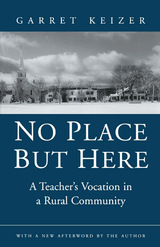
No Place But Here
A Teacher’s Vocation in a Rural Community
Garret Keizer
University Press of New England, 1996
Weaving anecdotal narrative with trenchant reflections on his profession, Garret Keizer offers one teacher's answer to the hue and cry over the crisis in education. An English teacher in rural Vermont, he writes of the opposing realities he faces every day: the promise and energy of the young and the oppressive effect of their economic disadvantages; the beauty of the countryside and its people and the harsh, sometimes ugly edge of life there; the need for discipline and the importance of rebellion. In exploring the demands peculiar to his own community, Keizer movingly depicts the difficulties-some triumphantly overcome, some overwhelming-that form the heart of teaching anywhere.
[more]
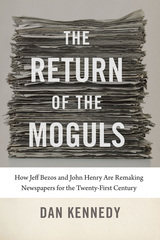
The Return of the Moguls
How Jeff Bezos and John Henry Are Remaking Newspapers for the Twenty-First Century
Dan Kennedy
University Press of New England, 2018
The Return of the Moguls chronicles an important story in the making, one that will affect more than just the newspaper business—it has the power to change democracy as we know it. Over the course of a generation, the story of the daily newspaper has been an unchecked slide from record profitability and readership to plummeting profits, increasing irrelevance, and inevitable obsolescence. The forces killing major dailies, alternative weeklies, and small-town shoppers are well understood—or seem obvious in hindsight, at least—and the catalog of publications that have gone under reads like a who’s who of American journalism. During the past half-century, old-style press barons gave way to a cabal of corporate interests unable or unwilling to invest in the future even as technological change was destroying their core business. The Taylor family sold the Boston Globe to the New York Times Company in 1993 for a cool $1.1 billion. Twenty years later, the Times Company resold it for just $70 million. The unexpected twist to the story, however, is not what they sold it for but who they sold it to: John Henry, the principal owner of the Boston Red Sox. A billionaire who made his money in the world of high finance, Henry inspired optimism in Boston because of his track record as a public-spirited business executive—and because his deep pockets seemed to ensure that the shrunken newspaper would not be subjected to further downsizing. In just a few days, the sale of the Globe was overtaken by much bigger news: Jeff Bezos, the founder of Amazon and one of the world’s richest people, had reached a deal to buy the Washington Post for $250 million. Henry’s ascension at the Globe sparked hope. Bezos’s purchase seemed to inspire nothing short of ecstasy, as numerous observers expressed the belief that his lofty status as one of our leading digital visionaries could help him solve the daunting financial problems facing the newspaper business. Though Bezos and Henry are the two most prominent individuals to enter the newspaper business, a third preceded them. Aaron Kushner, a greeting-card executive, acquired California’s Orange County Register in July 2012 and then pursued an audacious agenda, expanding coverage and hiring journalists in an era when nearly all other newspaper owners were trying to avoid cutting both. The newspaper business is at a perilous crossroads. This essential book explains why, and how today’s new crop of media moguls might help it to survive.
[more]
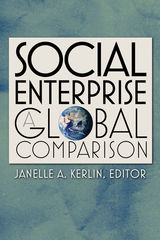
Social Enterprise
A Global Comparison
Janelle A. Kerlin
University Press of New England, 2009
Social enterprise—the use of market-based, civil society approaches to address social issues—has been a growing phenomenon for over twenty years. Gathering essays by researchers and practitioners from around the globe, this volume examines, from a local perspective, the diverse ways in which social enterprise has emerged in different regions. Each chapter examines the conceptualization, history, legal and political frameworks, supporting institutions, and latest developments and challenges for social enterprise in a given region or country. In the final chapter, Janelle A. Kerlin presents a comparative analysis of the various models and contexts for social enterprise, showing how particular strengths in each environment lead to different enterprise initiative models.
[more]

Trail Running Western Massachusetts
Ben Kimball
University Press of New England, 2015
Ben Kimball, a long-time trail runner, provides profiles of fifty-one great trail runs in western Massachusetts. Geographically, this book covers the area between the Quabbin Reservoir and upstate New York, including the Pioneer Valley and Berkshire areas as well as portions of the Taconic Highlands. Elevations range from the lowlands of the Connecticut River and Housatonic River valleys to the state’s highest point at the top of Mount Greylock. The trails profiled represent a range of locations within the region as well as a range of difficulty levels and terrain types. There are options for everyone, from the beginner to the experienced trail runner looking for new options. Each run receives a two-page treatment that includes an informative trail description and a trail map, along with a scannable QR code to download each map to your smartphone. This book will appeal to the entire running community of Massachusetts and the surrounding region, including the Pioneer Valley along the Connecticut River, communities along the Housatonic River corridor in the Berkshires, the many running clubs in the Boston area, and seasonal vacationers.
[more]

The Devil’s Cormorant
A Natural History
Richard J. King
University Press of New England, 2014
Behold the cormorant: silent, still, cruciform, and brooding; flashing, soaring, quick as a snake. Evolution has crafted the only creature on Earth that can migrate the length of a continent, dive and hunt deep underwater, perch comfortably on a branch or a wire, walk on land, climb up cliff faces, feed on thousands of different species, and live beside both fresh and salt water in a vast global range of temperatures and altitudes, often in close proximity to man. Long a symbol of gluttony, greed, bad luck, and evil, the cormorant has led a troubled existence in human history, myth, and literature. The birds have been prized as a source of mineral wealth in Peru, hunted to extinction in the Arctic, trained by the Japanese to catch fish, demonized by Milton in Paradise Lost, and reviled, despised, and exterminated by sport and commercial fishermen from Israel to Indianapolis, Toronto to Tierra del Fuego. In The Devil’s Cormorant, Richard King takes us back in time and around the world to show us the history, nature, ecology, and economy of the world’s most misunderstood waterfowl.
[more]
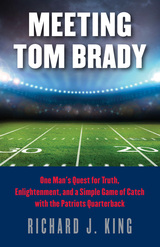
Meeting Tom Brady
One Man's Quest for Truth, Enlightenment, and a Simple Game of Catch with the Patriots Quarterback
Richard J. King
University Press of New England, 2015
Imagine that you are an average American man. You work hard and love football. Your present is a highway of unbounded opportunity, your future a far horizon unclouded by doubt. Then comes middle age. Who can you look to when the highway begins to crack, when opportunity shrinks to the size of a cubicle, and the horizon looms close? For Richard J. King, the answer is clear: Tom Brady. The legendary quarterback of the New England Patriots is not just a four-time Super Bowl champion, three-time MVP, and certain Hall of Famer. He is a male epitome. Gifted but humble. Driven but balanced. Aging but youthful. Devoted to both career and family. At the pinnacle of success but somehow still one of us. If anyone can point the way to living a worthy life, Tom Brady can. And so, at the start of the 2013 football season, King sets off in an ’88 Volkswagen minibus in a time-honored quest to answer life’s pressing questions—and to meet his hero. From training camp to the playoffs, from Spy-gate to Deflate-gate, King takes us on a tour of stadiums and bars across the country. Along the way he talks with players, sportswriters, and Patriots management, and poses the existential question, “What would you ask Tom Brady?” Meeting Tom Brady is funny and wise, a memoir of an eventful season in both King’s life and Brady’s—a determined pursuit, with uncertain results.
[more]

Memoirs and Reflections
Evgeny Kissin
University Press of New England, 2018
Evgeny Kissin is an internationally renowned classical pianist admired for his interpretations of the repertoires of Beethoven, Schubert, Chopin, Liszt, Schumann, Brahms, Rachmaninoff, and Prokofiev. The intensity of Kissin’s thinking animates this candid memoir, illuminating his astonishing memory, his fondness for his family and teachers, and his artistic sense of self. Memoirs and Reflections chronicles Kissin’s musical education and his early career. His writing is infused with his lifelong engagement with music: an obsessive love that captured, challenged, and nurtured him from a young age. He recounts fortuitous events and serendipitous encounters with remarkable musicians and conductors, including Herbert von Karajan. This book shows Kissin to be surprisingly modest and down-to-earth in spite of his astonishing gift. He writes of his family and friends with tender affection and touching detail. Reading this intimate memoir is like having a private audience with the great pianist himself.
[more]
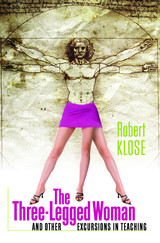
Robert Klose
University Press of New England
Since 1986, Robert Klose has taught biology at a “small, impoverished, careworn” college in central Maine. Located on a former military base, the school became first the South Campus of the University of Maine, or SCUM, and later, Penobscot Valley Community College, then Bangor Community College, and most recently University College of Bangor. Despite its improved nomenclature, University College of Bangor remains an open-admissions environment at which “one never knows what’s going to come in over the transom.” Klose’s nontraditional students have included, in addition to single parents and veterans, the homeless, the abused, ex-cons, and even a murderer (who was otherwise “a very nice person”). Chronicling his experiences teaching these diverse students, Klose describes with equal doses of care and wry wit those who are profoundly unfit for college, their often inadequate command of the lingua franca, and the alacrity with which they seize upon the paranormal (the three-legged woman) while expressing skepticism about mainstream science. He reflects on the decline of reading for enjoyment and the folly of regarding email as a praiseworthy substitute for expository writing. He details what works in the classroom, identifies what has failed, and relates stories of the absurd, the sublime, and the unanticipated, such as one student’s outburst following a discussion of evolution: “For what you have taught today you shall be damned to everlasting fires of hell!” Tempering thoughtfulness with a light touch and plenty of humor, these essays prove that teaching, an “imperfect occupation,” remains a “special profession.”
[more]
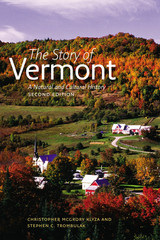
The Story of Vermont
A Natural and Cultural History, Second Edition
Christopher McGrory Klyza
University Press of New England, 2015
In this second edition of their classic text, Klyza and Trombulak use the lens of interconnectedness to examine the geological, ecological, and cultural forces that came together to produce contemporary Vermont. They assess the changing landscape and its inhabitants from its pre-human evolution up to the present, with special focus on forests, open terrestrial habitats, and the aquatic environment. This edition features a new chapter covering from 1995 to 2013 and a thoroughly revised chapter on the futures of Vermont, which include discussions of Tropical Storm Irene, climate change, eco-regional planning, and the resurgence of interest in local food and energy production. Integrating key themes of ecological change into a historical narrative, this book imparts specific information about Vermont, speculates on its future, and fosters an appreciation of the complex synergy of forces that shaped this region. This volume will interest scholars, students, and Vermonters intrigued by the state’s long-term natural and human history.
[more]
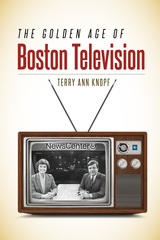
The Golden Age of Boston Television
Terry Ann Knopf
University Press of New England, 2017
There are some two hundred TV markets in the country, but only one—Boston, Massachusetts—hosted a Golden Age of local programming. In this lively insider account, Terry Ann Knopf chronicles the development of Boston television, from its origins in the 1970s through its decline in the early 1990s. During TV’s heyday, not only was Boston the nation’s leader in locally produced news, programming, and public affairs, but it also became a model for other local stations around the country. It was a time of award-winning local newscasts, spirited talk shows, thought-provoking specials and documentaries, ambitious public service campaigns, and even originally produced TV films featuring Hollywood stars. Knopf also shows how this programming highlighted aspects of Boston’s own history over two turbulent decades, including the treatment of highly charged issues of race, sex, and gender—and the stations’ failure to challenge the Roman Catholic Church during its infamous sexual abuse scandal. Laced with personal insights and anecdotes, The Golden Age of Boston Television offers an intimate look at how Boston’s television stations refracted the city’s culture in unique ways, while at the same time setting national standards for television creativity and excellence.
[more]

The Amish Struggle with Modernity
Donald B. Kraybill
University Press of New England, 1994
Throughout their history, the Amish communities of North America have tried to remain separate from the currents of progress that swirl in the larger society. The authors and others argue that although the nation’s nearly 140,000 Amish continue to resist the influence of worldly institutions, the communities have nonetheless acquiesced to modernity in significant ways. Such change has not been easy and The Amish Struggle with Modernity examines on a national scale dilemmas that arise when a people devoted to plain living face the complexities of modern life.
[more]
READERS
Browse our collection.
PUBLISHERS
See BiblioVault's publisher services.
STUDENT SERVICES
Files for college accessibility offices.
UChicago Accessibility Resources
home | accessibility | search | about | contact us
BiblioVault ® 2001 - 2024
The University of Chicago Press









